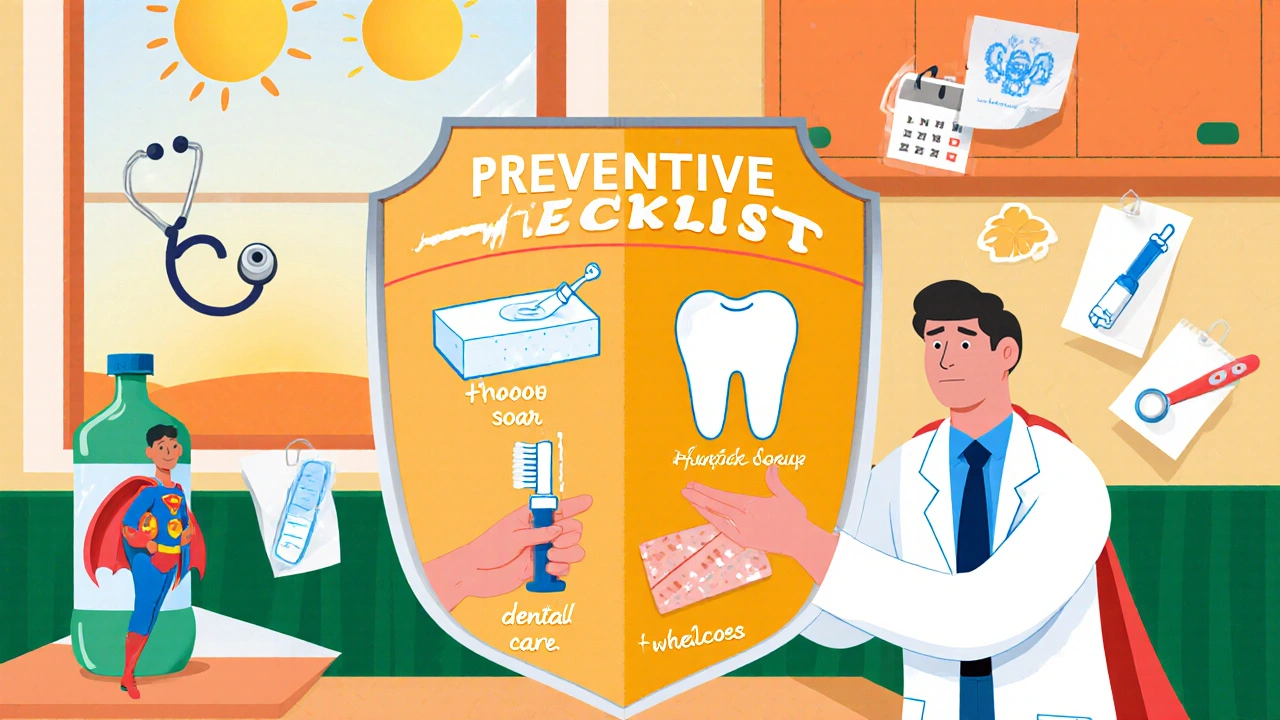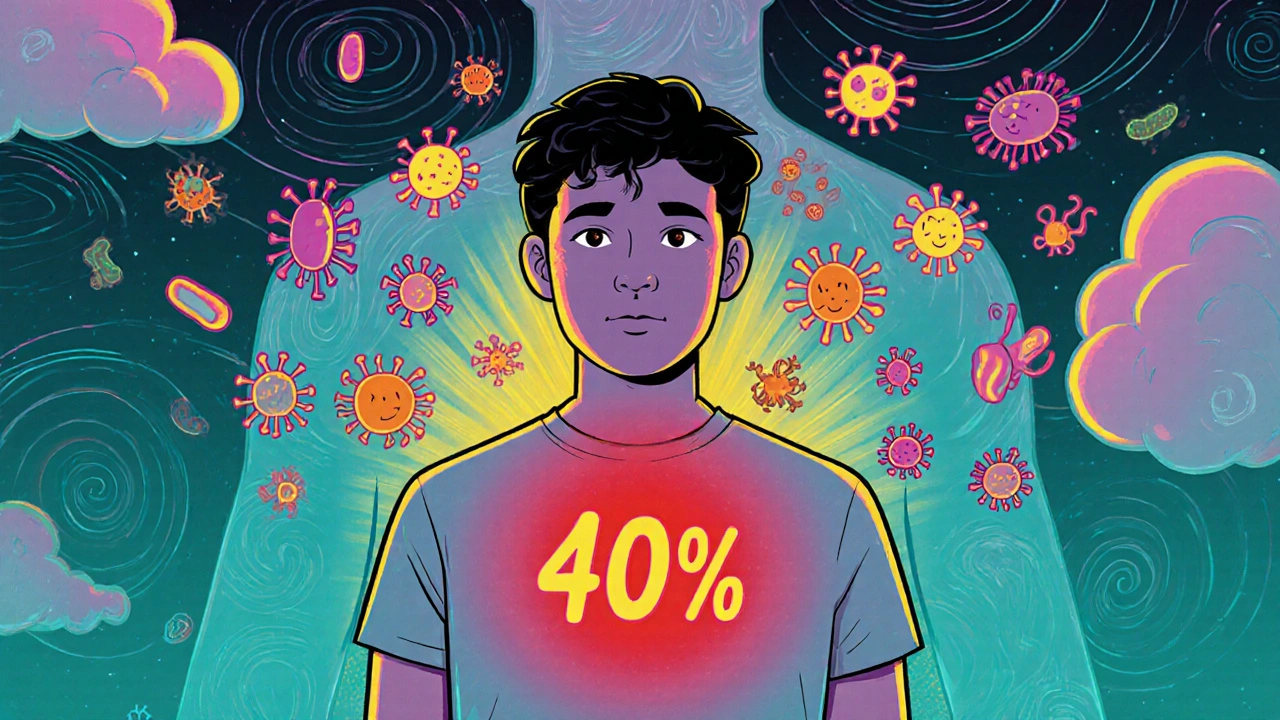Lupus Infection Symptom Checker
Assess Your Symptoms
Check any symptoms you're experiencing. This tool will help determine if you need immediate medical attention based on lupus-specific guidelines.
Results
Your Symptoms
Did you know that up to 40% of lupus flares are sparked by an Infection the invasion of the body by harmful microorganisms such as bacteria, viruses, fungi or parasites? When the immune system is already confused by Lupus a chronic autoimmune disease where the body attacks its own tissues, causing widespread inflammation, an extra insult can push it over the edge. This article breaks down why infections matter for people with lupus, which bugs are most likely to cause trouble, and practical steps you can take to stay safe.
Why Lupus Makes You More Vulnerable to Infections
At its core, lupus is an Autoimmune disease a condition in which the immune system mistakenly targets the body’s own cells and organs. The misdirected attack consumes immune resources, leaves immune cells exhausted, and often requires medication that deliberately dampens immunity. Two key factors increase infection risk:
- Immune dysregulation: Lupus patients produce abnormal Antibodies proteins that normally identify foreign invaders but in lupus also target self‑proteins, leading to chronic inflammation and impaired pathogen clearance.
- Immunosuppressive therapy: Drugs such as Corticosteroids potent anti‑inflammatory agents that reduce immune activity, Azathioprine an immunosuppressant that limits lymphocyte proliferation, or biologics (e.g., belimumab) shrink the body’s ability to fight microbes.
The combination means even a mild cold can become a serious health event for someone with lupus.
How Infections Trigger Lupus Flares
When an infection arrives, the body launches a cascade of signaling molecules called Cytokines small proteins that regulate immunity and inflammation. In a healthy person, this response clears the pathogen and then subsides. In lupus, the cytokine surge can act like a firestarter:
- Enhanced auto‑antibody production: Certain viral antigens mimic self‑structures, confusing B‑cells into making more auto‑antibodies.
- Complement activation: The Complement system a group of proteins that help antibodies clear microbes becomes over‑active, damaging blood vessels and kidneys.
- Breakdown of tolerance: Persistent inflammation erodes the regulatory T‑cell checkpoints that normally keep auto‑immunity in check.
The net result is a flare-new or worsening pain, rash, fatigue, or organ involvement.
Common Infections That Spark Lupus Flares
Not all bugs are equally risky. Below is a quick look at the usual suspects.
| Infection Type | Typical Trigger Mechanism | Precautionary Advice |
|---|---|---|
| Bacterial infection invasion by bacteria such as Staphylococcus or Streptococcus | Elevated pro‑inflammatory cytokines (IL‑6, TNF‑α) amplify auto‑antibody production. | Prompt antibiotic treatment; keep skin wounds clean; stay up‑to‑date on pneumococcal vaccine. |
| Viral infection infection caused by viruses like influenza, herpes simplex, or COVID‑19 | Molecular mimicry (viral proteins resemble self‑antigens) and interferon surge aggravate lupus. | Annual flu shot; consider COVID‑19 boosters; practice good hand hygiene. |
| Fungal infection invasive or superficial infection by fungi such as Candida | Occurs more often when steroids are high; can cause systemic inflammation. | Limit broad‑spectrum antibiotic use; monitor oral thrush; treat promptly with antifungals. |

Preventing Infections: A Practical Checklist
Staying infection‑free isn’t about living in a bubble; it’s about smart habits.
- Vaccinations are your frontline: Flu, pneumococcal, hepatitis B, and COVID‑19 vaccines are safe for most lupus patients and dramatically lower severe infection rates.
- Hand hygiene matters: Wash hands with soap for at least 20 seconds before meals, after using the bathroom, and after touching public surfaces.
- Dental care: Periodontal disease can seed bacteria into the bloodstream. Brush twice daily, floss, and see a dentist every six months.
- Skin integrity: Keep cuts covered, avoid sharing personal items, and use antiseptic wipes on minor abrasions.
- Monitor medication doses: Work with your rheumatologist to use the lowest effective steroid dose; consider steroid‑sparing agents when possible.
- Prompt medical attention: At the first sign of fever, cough, or urinary symptoms, contact your healthcare team. Early treatment cuts flare severity.
Managing an Infection When You Have Lupus
If an infection does break through, the goal is to clear the pathogen while keeping lupus activity in check.
- Accurate diagnosis: Your doctor may order cultures, PCR tests, or imaging to identify the culprit.
- Targeted therapy: Choose the narrowest‑spectrum antibiotic or antiviral that works. Over‑use of broad‑spectrum drugs can disrupt gut flora and worsen auto‑immunity.
- Adjust immunosuppression: Short‑term reduction of steroids or pausing certain biologics may be advised, but never stop meds abruptly without guidance.
- Supportive care: Adequate hydration, rest, and nutrition help the immune system recover.
- Close monitoring: Keep a symptom diary, track temperature, and schedule follow‑up labs (CBC, complement levels, anti‑dsDNA) to catch any flare early.
Collaboration between your rheumatologist, primary care physician, and, if needed, an infectious‑disease specialist yields the best outcomes.

When to Seek Immediate Help
Some infection‑related scenarios demand urgent attention:
- High fever (>38.5 °C) lasting more than 24 hours.
- Severe chest pain, shortness of breath, or sudden swelling of the legs (possible pneumonia or deep‑vein thrombosis).
- New onset of neurological symptoms-headache, confusion, or seizures (think meningitis or lupus neuro‑flare).
- Rapidly worsening rash or joint pain that doesn’t improve with usual meds.
Calling emergency services or heading to the nearest hospital can prevent a life‑threatening cascade.
Key Takeaways
- Lupus patients are about two‑to‑three times more likely to develop serious infections.
- Both bacterial and viral infections can ignite lupus flares by flooding the body with cytokines and auto‑antibodies.
- Vaccinations, good hygiene, and careful medication management are the most effective preventive tools.
- If infection strikes, early diagnosis, tailored antimicrobial therapy, and a temporary tweak of immunosuppressives are critical.
- Never ignore high fevers or new organ‑specific symptoms-seek medical care right away.
Frequently Asked Questions
Can flu shots cause a lupus flare?
The flu vaccine is inactivated, meaning it contains no live virus. Studies show it does not increase flare rates and actually reduces the risk of severe influenza‑related complications.
Why do antibiotics sometimes worsen lupus symptoms?
Broad‑spectrum antibiotics can disrupt the gut microbiome, which plays a role in regulating immune tolerance. An imbalance may temporarily boost inflammation, mimicking a flare. Using the narrowest effective drug helps avoid this.
Are there specific infections that I should be extra wary of?
Respiratory infections (influenza, COVID‑19, pneumonia) and urinary‑tract infections are the most common triggers. Skin infections from Staphylococcus and opportunistic fungal infections (Candida) also pose a risk, especially when steroids are high.
Should I stop my lupus medication if I get a cold?
Never stop meds on your own. A mild cold usually doesn’t require a change, but if symptoms worsen, your doctor may temporarily lower steroid dose or pause a biologic. Always discuss changes first.
How often should I get vaccinated?
Annual flu vaccination is a must. Pneumococcal vaccine is recommended once, with a booster five years later. COVID‑19 boosters follow the same schedule as the general population, but you may need them sooner if on high‑dose immunosuppressants.


barnabas jacob 20.10.2025
Yo, if u think lupus flares are just "bad luck," think again – the immuno‑dysregulation axis is basically a perfect storm for opportunistic pathogens. The cytokine cascade, especially IL‑6 and TNF‑α, acts like a rogue algorithm spitting out auto‑antibodies. You gotta recognize that immunosuppressive regimens are a double‑edged sword: they blunt the immune response but also open the door for bacterial/viral infiltration. So, maintaining prophylactic vaccines ain't just a nice‑to‑have, it's a mandatory QA checkpoint.
jessie cole 20.10.2025
My dear friend, I wholeheartedly salute your dedication to understanding this complex interplay. It is indeed a noble quest to balance treatment efficacy with infection prevention, and your vigilance will serve as a beacon of hope for many. Let us remember that every precaution-be it a flu shot or diligent hand‑washing-adds a layer of armor against the unseen adversary. Together, we shall navigate these challenges with grace and resolve.
Deja Scott 20.10.2025
In many cultures, communal support plays a crucial role in managing lupus flares.
Natalie Morgan 20.10.2025
Community networks provide emotional backup and practical help like reminders for meds and appointments
They also foster sharing of vaccination experiences which can demystify fears
Mahesh Upadhyay 20.10.2025
Stop whining, the data simply shows that high‑dose steroids double infection risk, plain and simple.
Rajesh Myadam 20.10.2025
I hear your frustration, and while the numbers are stark, it's important to work with your rheumatologist to find the lowest effective dose. Small adjustments can make a big difference in both flare control and infection susceptibility.
laura wood 20.10.2025
It's heartbreaking to see patients caught between debilitating pain and the fear of a new infection. Maintaining good oral hygiene and staying up to date on vaccinations are small steps that can provide big peace of mind.
Kate McKay 20.10.2025
Absolutely, you've got this! Taking the initiative to schedule your flu shot ahead of the season is a proactive move that many overlook. Remember to keep a symptom diary; noting even minor changes can alert your care team early. Also, don't hesitate to ask about adjusting any immunosuppressants during a cold-sometimes a tiny tweak prevents a full‑blown flare. Keep pushing forward, your resilience is inspiring.
Demetri Huyler 20.10.2025
One cannot help but notice how Western medical literature often glosses over the nuanced differences in infection susceptibility across ethnic groups. The immunogenetic profiles of certain populations, particularly those with higher HLA‑DR alleles, may predispose them to more aggressive lupus‑related infections. Yet the mainstream discourse remains stubbornly monolithic, ignoring the rich tapestry of genetic diversity. It would serve the scientific community well to integrate these epidemiological variances into personalized prophylactic strategies. Until then, we are merely scratching the surface of a deeply complex issue.
JessicaAnn Sutton 20.10.2025
Frankly, the omission you highlighted is a glaring oversight that undermines the article's credibility; a rigorous author would have incorporated such demographic data rather than presenting a one‑size‑fits‑all narrative. Moreover, the blanket recommendation for vaccination fails to address potential contraindications in specific subpopulations, which is a basic lapse in clinical judgement.
Israel Emory 20.10.2025
Wow-what a comprehensive overview!; however, one must ask: are we truly addressing the root cause, or merely treating the symptoms?; the article skims over the critical point that immunosuppressive dosage calibration is essential; without precise titration, patients remain vulnerable!
Wesley Humble 20.10.2025
Indeed, the pharmacokinetic profiles of corticosteroids such as prednisone reveal a dose‑dependent suppression of T‑cell proliferation, which directly correlates with infection rates 📊. Moreover, recent meta‑analyses emphasize that tapering protocols can mitigate this risk without compromising disease control 🌟. It's imperative that clinicians balance these variables to optimize patient outcomes.
Ron Lanham 20.10.2025
It is a profound disappointment that many patients continue to be fed misinformation regarding the simple notion that “just a cold” is harmless for those battling lupus. First, the immune dysregulation intrinsic to lupus creates a precarious baseline that any microbial insult can destabilize. Second, the immunosuppressive agents prescribed to control disease activity, while life‑saving, erode the very defenses that would normally neutralize a viral or bacterial pathogen. Third, the cascade of cytokines released during an infection does not merely combat the invader; it also ignites auto‑antibody production, thereby amplifying disease activity. Fourth, the resulting flare can manifest not only as joint pain or skin rash but also as severe organ involvement, including nephritis or neuro‑psychiatric complications. Fifth, delayed recognition of an infection due to attributing symptoms to a routine flare can postpone critical treatment, leading to hospitalization. Sixth, vaccination protocols, despite occasional concerns, have been shown in robust studies to reduce both infection incidence and flare frequency. Seventh, good hand hygiene, regular dental check‑ups, and prompt treatment of minor wounds are not optional niceties but essential components of a comprehensive care plan. Eighth, patients must maintain open communication with their rheumatologists, reporting any fever or respiratory symptoms immediately. Ninth, the healthcare team should consider temporary adjustment of immunosuppression during active infection, always under professional guidance. Tenth, multidisciplinary collaboration, involving infectious disease specialists when needed, optimizes outcomes. Eleventh, the psychological burden of fearing infection often leads patients to social isolation, which in turn can affect mental health and disease perception. Twelfth, support groups provide a vital platform for sharing coping strategies and up‑to‑date information. Thirteenth, the financial cost of untreated infections is substantial, underscoring the economic incentive for preventive measures. Fourteenth, technology such as telemedicine offers timely consultations that can avert unnecessary ER visits. Fifteenth, education initiatives aimed at both patients and primary care providers can close knowledge gaps that perpetuate risky practices. Lastly, the overarching message is clear: proactive infection prevention is not a peripheral concern-it is central to the effective management of lupus, and we must all commit to this reality.
Andrew Hernandez 20.10.2025
Your points are thorough and underscore the importance of a proactive approach
Alex Pegg 20.10.2025
While I acknowledge the preventive emphasis, it's worth noting that overt medicalization can sometimes strip patients of autonomy, leading to dependence on endless protocols rather than fostering personal resilience.